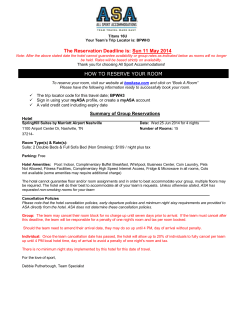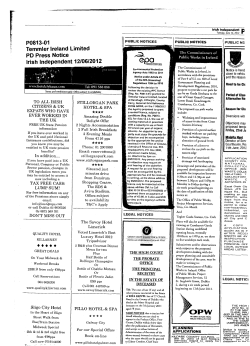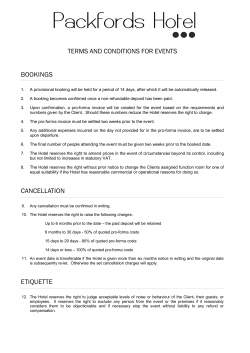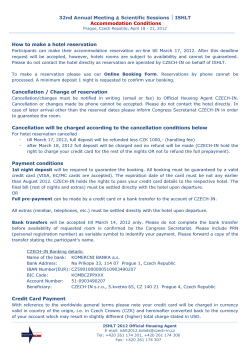
H o w
White Paper How to Meet Guest Demands Cost Effectively PROBLEM “The number one amenity motivating a guest in choosing a hotel is high speed internet access.” TechNews 2006. High Speed Internet Access (HSIA) has now made significant penetration into the hospitality marketplace which has transitioned guest purchasing decisions to not only choosing hotels that have HSIA but making decisions based on the HSIA experience. Hotels are now being forced to provide greater quality service to meet the increasing demands for bandwidth by the guest. Whether the hotel charges for HSIA or gives it away for free, the bandwidth costs to meet guest demand are not in the budget. The Marriott Mt. Laurel was completing a renovation from the Sheraton franchise to the Marriott franchise in early 2006. In the renovation, the property eliminated an old wired HSIA technology that had been installed seven years previous. To meet the demands of the changing clientele, the property installed a Cat5 wired solution to each room as well as a robust wireless solution throughout the property. To meet the expectation of the guests for the new HSIA network, the hotel knew it would need to provide significant bandwidth to the network. The standard options for bandwidth were T-1, muxed T-1’s, or DS3. While a single T-1 would not provide the required bandwidth, the hotel did not have a budget to bring in the additional options. With the capital investment made in the network, the hotel needed a proactive solution that met both the operational demands as well as the financial constraints. SOLUTION The property worked with Warner Consulting Group (WCG) to research and implement a smart growth, cost effective solution that will grow with their needs. To solve the problem, WCG looked at both the telecommunications and technology in a comprehensive manner. By combining the two departments, WCG could provide a short and long term strategy that would keep costs down while providing all the necessary guest requirements for both departments. WHAT IS DYNAMIC ALLOCATION? Dynamic Allocation is a carrier grade VOIP product that brings 12 – 30 voice lines per T-1 delivered in traditional analog or digital configuration while also providing 1.5Mbps of managed data on the same T-1. The voice is converted to data (20 – 40k) by the onsite carrier equipment. Voice takes priority and the data bandwidth is automatically allocated based on the voice usage. No changes are made to the hotels current on site equipment. The first step was to review and reconfigure the telecommunications facilities to reduce the expenses and meet the current hotels requirements. To accomplish this, WCG converted both voice T-1’s to dynamic allocation T-1’s giving the hotel the voice lines necessary (28 digital channels, two way DID) to operate while delivering two 1.5Mbps managed connections. By making this change, the hotel brought $23,293.56 in annual cost savings back to the bottom-line. Warner Consulting Group, LLC • 4027 Patricia Drive. • Columbus, Ohio 43220 (phone) 614-486-4636 • (fax) 866-321-7987 • www.warnerconsultinggroup.com White Paper The second step was to provide the bandwidth guests would expect from the new HSIA network. To accomplish this, WCG brought in Elfiq’s Link LB 1000 load balancing solution to allow the property to increase bandwidth at a manageable cost. The hotel could now use both dynamic allocation T-1’s in combination with a 6Mbps x 1Mbps cable connection for the guest rooms. The total solution gave the property a 9Mbps x 4Mbps guest connection. Marriott Mt Laurel Network Configuration - 9Mbps x 4Mbps Bandwidth Connection Redundant Network ISP’s Scalable To Meet Future Needs Efficient Utilization Of T-1 Facilities By comparing the solution implemented to a traditional approach of two voice only T-1’s and a muxed 3Mbps solution or DS3 solution, the return on investment was three months. The cost for two dynamic allocation T-1’s was the same as two voice only T-1’s. Any cost for bandwidth such as a managed 3Mbps ($1,000 per month) solution would have increase the hotels monthly cost to do business. Most importantly, the solution that was implemented delivered the guest a much greater bandwidth connection (9Mbps x 4Mbps) than could be cost effectively achieved through traditional methods. The Elfiq solution has allowed WCG and the hotel to monitor traffic to continually load balance between the circuits with optimal performance. With one port open and three total ports for secondary bandwidth, the hotel has the capability to add additional bandwidth in the future as the guest demands change. The Elfiq solution also gave the hotel redundant internet connections by using different providers for the bandwidth connections (the load balancing technology automatically reroutes traffic if a link fails or is temporarily out of service). The total solution was implemented in under three weeks as opposed to 4-6 weeks for a typical T-1 solution. By utilizing the products and services available to the property, the hotel was able to bring money back down to the bottom-line while insuring they will continue to meet guest’s growing demands. Warner Consulting Group, LLC • 4027 Patricia Drive. • Columbus, Ohio 43220 (phone) 614-486-4636 • (fax) 866-321-7987 • www.warnerconsultinggroup.com
© Copyright 2025





















